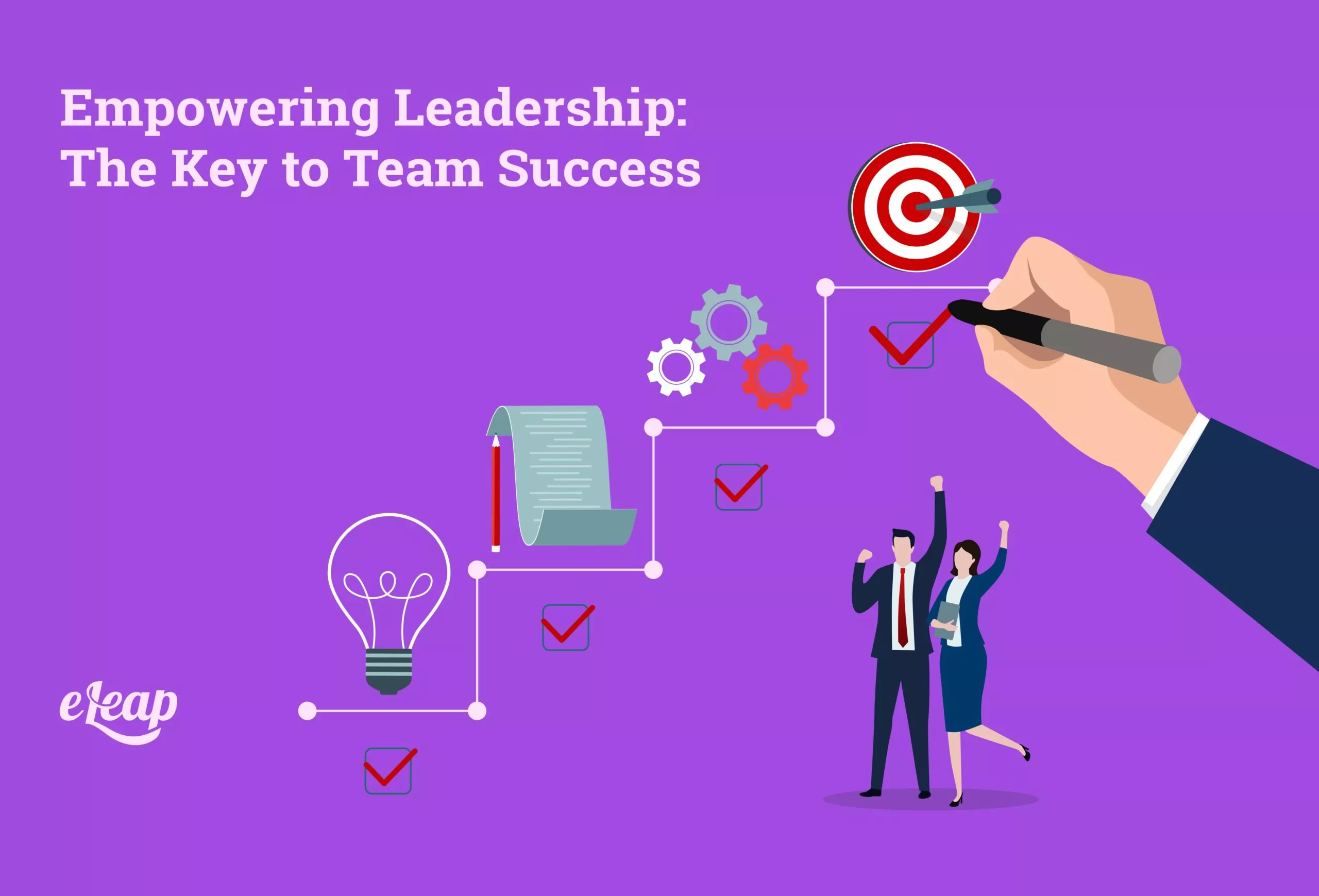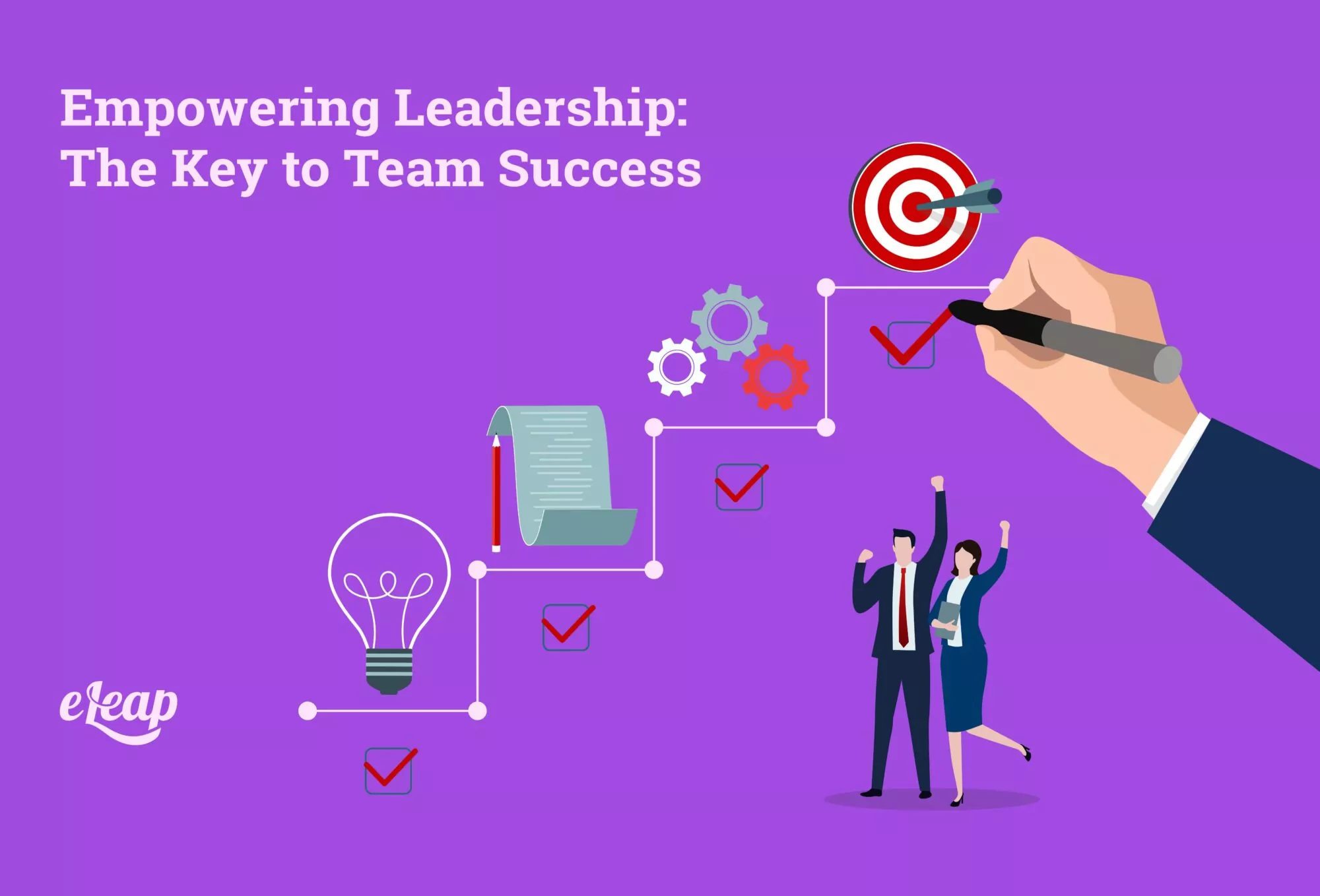Empowering Leadership: The Key to Team Success

In the modern business world, leadership is evolving rapidly. The traditional, authoritarian approach gives way to a more empowering model emphasizing collaboration, growth, and autonomy. Empowering leadership is not just a buzzword—it’s a fundamental shift in how leaders inspire their teams to perform at their highest potential. In this article, we will explore what empowering leadership truly means, its key characteristics, its benefits to organizations, how to implement it effectively, and the challenges leaders face in trying to empower their teams. Explore how eLeaP®’s Performance Management Platform can simplify evaluations, boost productivity, and drive measurable results.
What is Empowering Leadership?

Empowering leadership is a leadership style that focuses on providing employees with the tools, confidence, and autonomy they need to succeed. It’s about creating an environment where team members feel motivated, supported, and trusted to make decisions impacting their work. Unlike traditional leadership, where top leaders make decisions and pass them down to employees, empowering leadership emphasizes delegation, responsibility, and collaboration.
At its core, empowering leadership aims to unlock the potential of individuals within the team. Leaders who adopt this style act more as coaches and mentors than authoritarian figures, guiding their teams toward achieving common goals. The result is a more engaged and motivated workforce, which translates into higher performance, innovation, and employee satisfaction.
Characteristics of Empowering Leadership
Empowering leadership thrives on key characteristics that foster trust, collaboration, and personal growth. Let’s explore these essential traits further.
Strong Communication Skills
One of the primary pillars of empowering leadership is strong communication. Leaders must clearly articulate goals, expectations, and strategies while being open to feedback. Communication in this context goes beyond simply issuing instructions—creating a dialogue where employees feel heard and valued. Leaders who are effective communicators actively listen to their team members and encourage open discussion, which leads to a more inclusive and innovative work environment.
Leaders also need to set clear expectations from the outset. When employees understand their expectations, they can work more independently and effectively. At the same time, open communication channels ensure employees feel comfortable asking questions or seeking guidance when needed.
Delegation and Trust
Empowering leadership is closely tied to the ability to delegate effectively. It’s not just about offloading tasks; it’s about trusting employees with significant responsibilities. This trust is crucial because it allows individuals to own their work, make decisions, and feel accountable for the outcomes.
By empowering employees with decision-making authority, leaders demonstrate confidence in their team’s abilities. This autonomy encourages employees to take more initiative and develop problem-solving skills. However, leaders must provide the necessary support and guidance without micromanaging, creating a balanced approach where employees feel trusted but not abandoned.
Promoting Employee Growth
Empowering leaders prioritize the growth and development of their team members. They actively seek opportunities for employees to learn, improve, and advance in their careers. This process might involve providing access to training programs, mentorship, or stretch assignments that challenge employees to step outside their comfort zones.
By investing in employees’ personal and professional growth, leaders improve their teams’ capabilities and foster loyalty and engagement. When employees feel that their leader genuinely cares about their development, they are likelier to remain committed to the organization and contribute at a high level.
Emotional Intelligence
Emotional intelligence (EQ) is the ability to understand and manage one’s emotions and recognize and influence the feelings of others. Leaders with high emotional intelligence are better equipped to navigate the complexities of empowering leadership. They can motivate, inspire, and manage team dynamics with empathy and understanding, which is crucial for building a supportive, cohesive team.
Empowering leaders use emotional intelligence to build strong relationships with their team members. They understand when to encourage, when to step back, and when to challenge their team to grow. Emotional intelligence helps leaders navigate difficult conversations, resolve conflicts, and create an environment where employees feel safe to take risks and express themselves.
Benefits of Empowering Leadership
Empowering leadership benefits employees and significantly impacts the organization as a whole. When leaders empower individuals, they create ripple effects that lead to higher employee engagement, increased productivity, and overall team success.
Increased Employee Engagement and Productivity
When employees feel empowered, they are more engaged in their work. Empowered employees are likelier to take ownership of their tasks, contribute innovative ideas, and go the extra mile to meet organizational goals. Studies have shown that organizations with highly engaged employees have better performance outcomes, including higher productivity, profitability, and customer satisfaction.
Empowering leadership creates an environment where employees feel that their contributions matter. When employees are engaged, they are more focused, more motivated, and ultimately more productive. This stage leads to higher efficiency and better results across the board.
Stronger Workplace Culture and Trust
Trust is the foundation of any successful team, and empowering leadership is crucial in building it. When leaders trust their employees to make decisions and contribute meaningfully, it creates a culture of mutual respect. Employees feel valued and trusted, which leads to stronger team dynamics, improved morale, and higher levels of collaboration.
A culture of empowerment encourages openness, creativity, and shared responsibility. When employees feel their leader has confidence in their abilities, they are more likely to collaborate with their peers, share ideas, and work toward common goals. This step fosters a positive workplace culture where trust is central to every interaction.
Enhanced Innovation and Creativity
Empowering leadership encourages employees to think independently and challenge the status quo. When leaders give their teams the autonomy to make decisions and solve problems, it opens the door to innovation and creative thinking. Empowered employees are likelier to take risks, experiment with new ideas, and propose solutions to drive the organization forward.
The ability to innovate is crucial in today’s fast-paced business environment. Empowering leaders creates an atmosphere where creativity thrives, and employees are encouraged to think outside the box. This process leads to continuous improvement and the ability to stay ahead of competitors in a constantly changing market.
Lower Employee Turnover
Employee turnover can be costly for businesses in terms of time and resources. One of the significant advantages of empowering leadership is its impact on employee retention. Employees who feel trusted, respected, and invested in are less likely to leave their jobs. Empowered employees tend to have higher job satisfaction, which leads to greater loyalty and a more substantial commitment to the organization.
Empowering leaders creates a positive work environment that employees are eager to stay in by providing opportunities for growth, recognition, and autonomy. This stage reduces turnover and helps companies retain their top talent.
How to Implement Empowering Leadership in Your Organization
Implementing empowering leadership requires more than just a change in mindset—it involves concrete actions and strategies that leaders can use to foster an environment of trust, growth, and collaboration. Here are some practical steps for implementing empowering leadership.
Set Clear Expectations and Provide Guidance
Empowering leadership starts with clarity. Leaders must set clear goals, expectations, and performance benchmarks for their team members. When employees understand their expectations, they can work independently and confidently. However, setting clear expectations is not enough. Leaders must also provide the necessary resources, support, and guidance to help employees achieve their goals.
Involve Employees in Decision-Making
One key feature of empowering leadership is involving employees in decision-making. This process doesn’t mean leaders must include everyone in every decision, but it’s about creating a culture of collaboration where employees feel their input matters. Leaders can involve their teams in decisions that affect their work, such as setting priorities, developing strategies, or solving problems. This step gives employees a sense of ownership and increases their investment in the outcomes.
Provide Opportunities for Growth and Development
To truly empower employees, leaders must prioritize their growth and development. This stage means offering learning opportunities, mentorship, and challenging employees to step outside their comfort zones. Empowering leaders encourage their teams to pursue new skills, attend professional development workshops, and take on new challenges that help them grow personally and professionally.
By investing in employee development, leaders create a capable, engaged, and committed workforce that will contribute to the organization’s success.
Recognize and Celebrate Success
Empowering leaders take the time to recognize and celebrate their team’s achievements. Recognition goes beyond just providing positive feedback—it acknowledges the effort, creativity, and initiative employees put into their work. Recognition can come in many forms, from a simple thank-you to more formal rewards and accolades. When employees feel their hard work is appreciated, they are more motivated to continue performing at a high level.
Challenges in Empowering Leadership
While empowering leadership can be highly effective, it has challenges. Leaders must prepare to face obstacles as they work to empower their teams.
Balancing Autonomy with Support
One of the biggest challenges of empowering leadership is finding the right balance between giving employees autonomy and providing the necessary support. Leaders must learn to trust their team members while ensuring they have the resources and guidance they need to succeed. It’s a fine line between offering freedom and ensuring accountability.
Managing Resistance to Change
Some employees may resist empowering leadership, mainly if they are used to traditional, authoritative leadership styles. Leaders must be patient and persistent in demonstrating the benefits of empowerment and showing employees how they can succeed in an empowered environment.
Building Confidence in Employees
Empowering leadership requires employees to step outside their comfort zones and take on new challenges. Some employees may lack confidence in making decisions or taking risks. Leaders can help build confidence by offering support, encouragement, and training that helps employees develop their skills and trust their abilities.
Conclusion
Empowering leadership is an essential approach to building high-performing, engaged teams. By focusing on communication, trust, delegation, and growth, leaders can create an environment where employees feel motivated and capable of achieving their best work. The benefits of empowering leadership are clear: increased productivity, stronger workplace culture, more significant innovation, and lower turnover. While challenges exist, the rewards are well worth the effort. Leaders who embrace this style contribute to their teams’ success and create lasting impact on their organizations’ growth and success.
Empowering leadership will remain a cornerstone of success as organizations continue to evolve. Adopting empowering leadership practices is the way forward for businesses looking to foster an environment of collaboration, innovation, and growth.